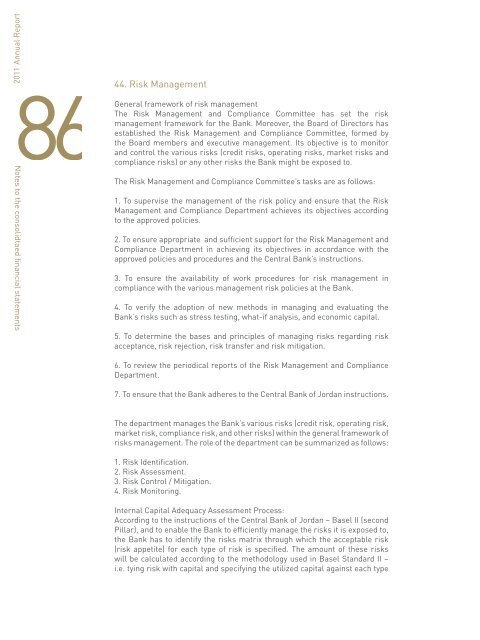Annual Report 2011 - Jordan Investment and Finance bank
Annual Report 2011 - Jordan Investment and Finance bank
Annual Report 2011 - Jordan Investment and Finance bank
Create successful ePaper yourself
Turn your PDF publications into a flip-book with our unique Google optimized e-Paper software.
8644.Notes to the consolidtaed financial statementsRisk ManagementGeneral framework of risk managementThe Risk Management <strong>and</strong> Compliance Committee has set the riskmanagement framework for the Bank. Moreover, the Board of Directors hasestablished the Risk Management <strong>and</strong> Compliance Committee, formed bythe Board members <strong>and</strong> executive management. Its objective is to monitor<strong>and</strong> control the various risks (credit risks, operating risks, market risks <strong>and</strong>compliance risks) or any other risks the Bank might be exposed to.The Risk Management <strong>and</strong> Compliance Committee’s tasks are as follows:1. To supervise the management of the risk policy <strong>and</strong> ensure that the RiskManagement <strong>and</strong> Compliance Department achieves its objectives accordingto the approved policies.2. To ensure appropriate <strong>and</strong> sufficient support for the Risk Management <strong>and</strong>Compliance Department in achieving its objectives in accordance with theapproved policies <strong>and</strong> procedures <strong>and</strong> the Central Bank’s instructions.3. To ensure the availability of work procedures for risk management incompliance with the various management risk policies at the Bank.4. To verify the adoption of new methods in managing <strong>and</strong> evaluating theBank’s risks such as stress testing, what-if analysis, <strong>and</strong> economic capital.5. To determine the bases <strong>and</strong> principles of managing risks regarding riskacceptance, risk rejection, risk transfer <strong>and</strong> risk mitigation.6. To review the periodical reports of the Risk Management <strong>and</strong> ComplianceDepartment.7. To ensure that the Bank adheres to the Central Bank of <strong>Jordan</strong> instructions.The department manages the Bank’s various risks (credit risk, operating risk,market risk, compliance risk, <strong>and</strong> other risks) within the general framework ofrisks management. The role of the department can be summarized as follows:1. Risk Identification.2. Risk Assessment.3. Risk Control / Mitigation.4. Risk Monitoring.Internal Capital Adequacy Assessment Process:According to the instructions of the Central Bank of <strong>Jordan</strong> – Basel II (secondPillar), <strong>and</strong> to enable the Bank to efficiently manage the risks it is exposed to,the Bank has to identify the risks matrix through which the acceptable risk(risk appetite) for each type of risk is specified. The amount of these riskswill be calculated according to the methodology used in Basel St<strong>and</strong>ard II –i.e. tying risk with capital <strong>and</strong> specifying the utilized capital against each typeof risk. Consequently, the higher the risks, the greater the Bank’s need forcapital to cover these risks. This methodology will help the Bank in connectingrisk appetite with capital, monitoring risk limits to determine the Bank’s riskprofile size, <strong>and</strong> perform amendments to reach the targeted risk appetite.The Bank has identified the risks to be measured, managed, <strong>and</strong> controlledas follows:1. Credit Risk.2. Market Risk.3. Operational Risk.4. Concentration Risk:• Credit Concentration Risk.• Other Concentration Risks5. Residual Risk:• From adopting credit risk mitigation through the st<strong>and</strong>ard method.• From applying the simple indicator method of the operating risk account.• From using the st<strong>and</strong>ard method of the market risk account.6. Interest Rate Risk in the Banking Book.7. Liquidity Risk.8. Strategic Risk.9. Reputation Risk.10. Business Cycle.11. Compliance Risk.12. Stress Test.44. a. Credit RisksCredit risks are defined as the probability of not fully recovering the debt orinterest in the specified time causing financial losses to the Bank.Moreover, credit risk represents the major portion <strong>bank</strong>s are exposed to ingeneral (representing 60% or 70% of the risks <strong>bank</strong>s are exposed to). Inrecognition of this reality, the Bank has accorded credit risk management greatsignificance through managing credit risks at the portfolio level, economicsector level, group level, or single customer level, taking into considerationthe achievement of an appropriate return on the risks the Bank is exposed to.To achieve this, based on the risk management strategy, the Bank hasperformed the following:1. The risk appetite <strong>and</strong> ceilings are based on credit risk commensuratewith the acceptable risk limits adopted by the Board of Directors <strong>and</strong> Risks<strong>and</strong> Compliance Department. Risk limits are set for each client, group <strong>and</strong>economic sector, in order to mitigate the Bank’s exposure to credit riskconcentrations.2. A risk rating system is prepared. It consists of 12 degrees <strong>and</strong> takes intoaccount all factors leading to increased credit risk for the client. In addition,it helps the Bank to detect the credit risk early on so that it can address<strong>and</strong> mitigate the risk before it increases. Moreover, the Bank has signed an87Notes to the consolidtaed financial statements



